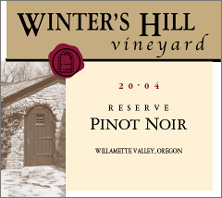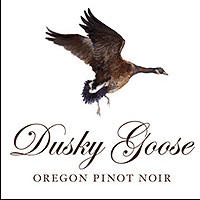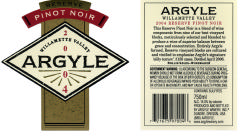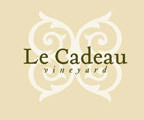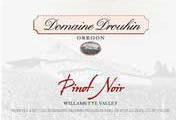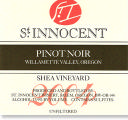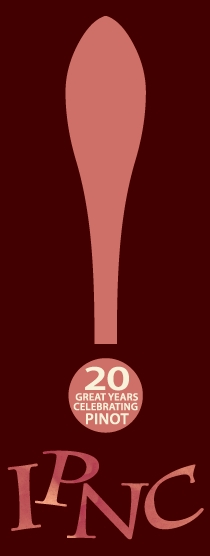PinotFile: 6.15 February 12, 2007
|
Oregon Pinot Noir 2004Oregon may seem anachronistic in comparison to California, but it’s Pinot Noirs are thoroughly modern. Oregon got a bit of late start in winegrowing. The first serious vinifera vineyards were planted in the mid 1960s by pioneers such as David Lett, Dick Erath, and the Sokol-Blossers, among others. It did not take Oregon long to catch up. In 1970, there were 5 wineries and 35 vineyard acres; today there are more than 11,100 vineyard acres and 364 wineries. Oregon has the third largest numbers of wineries in the United States behind California (1,905) and Washington state (430). Pinot Noir is the most widely planted grape by far (nearly 50% of all vineyard plantings), but 41 varietals are scattered in vineyards throughout the state. Although Oregon has done well to promote its healthy wine industry, a few curiosities arise. The state beverage is milk despite the fact that wine is now the state’s most visible agricultural product and the state flower is the Oregon grape which is actually a holly bush and not a wine grape at all. Rain is synonymous with Oregon, but unfairly so, for in the Willamette Valley where much of wine grape farming occurs, there is no more rain than other cool-climate wine growing regions of the world. That is not to say that rain isn’t a problem, for much of Oregon’s rainfall occurs in the spring and fall (as well as through the winter), with dry conditions in mid summer. The Willamette Valley was Oregon’s first formal American Viticultural Area (AVA), created in 1984. Unofficially, it is divided into north and south halves along the 45th parallel and extends from Portland in the north to Eugene in the south. There are now 15 AVAs in Oregon and 6 sub-AVAs in the Willamette Valley. The newest AVA, Chehalem Mountains, was only recently approved. The sub-AVA designations have started to appear on wine labels (replacing ‘Willamette Valley’) with the 2004 and 2005 vintages. A map of the sub-AVAs of the Willamette Valley is on page 2. The AVAs are largely characterized by their soils. There are two main types: (1) red volcanic basalt soils known as ’Jory’ from 13 million year-old lava flows, and (2) brown marine sedimentary soils known as “Willakenzie’ laid down under the ocean 20 million years ago. The AVAs encompass hillsides with vineyards located at 200-1000 ft. The valley floor is composed of rich, alluvial soils which are best suited for crops such as grain, grass seed, and fruit trees. 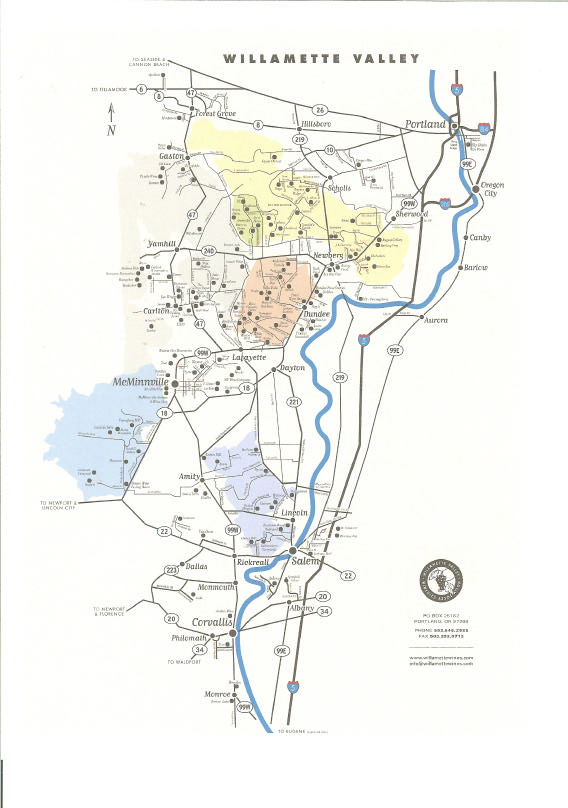 Key: Yellow - Chehalem Mountains; Beige - Yamhill-Carlton; Green - Ribbon Ridge; Orange - Dundee Hills; Light Blue - McMinnville; Dark Blue - Eola-Amita Hills Some generalizations regarding flavor and style of Pinot Noir can be made for the appellations based on the differences in soil type. The AVAs with Jory soils like Dundee Hills, Eola-Amity Hills and parts of Chehalem Mountains and McMinnville tend to produce Pinot Noirs with bright red fruits including cherry and raspberry, and are softly textured. The Pinot Noirs from AVAs with Willakenzie soils like Yamhill-Carlton, Ribbon Ridge, and parts of Chehalem Mountains and McMinnville typically offer more dark fruit, spice (cola, anise), and wet leaf flavors and tend to be more tannic and structured. By magnifying the map on page 2, you can pinpoint many prominent Oregon wineries to their appellation. The best way to get a feel for the Willamette Valley terrain is to visit. All of the appellations are contiguous, easily explored by car over the course of a few days, and only a 45-90 minute drive from Portland. Vintages in Oregon are, like Burgundy, at the mercy of climatic conditions during the growing season. From 1995-1997, Oregon experienced extremes of rainfall which led to poor vintages for Pinot Noir. Then there was a run of consistently fine vintages from 1998 until 2002. 2003 was an anomaly, the hottest and driest year on record in the Willamette Valley. The Pinot Noirs had elevated sugar levels, high extraction, high alcohol, and raisin flavors. 2004, 2005, and 2006 resumed the string of fine vintages prior to 2003. According to winegeeks.com, the following vintages were “great”: 1998, 2000, 2001, and 2003, and the remaining ones “outstanding”: 1999, 2002, and 2004. Oregon Wine Press (Dec 2006/January 2007) calls the 2006 vintage ‘close to perfect,’ with plentiful yields combined with mature flavors.
The Oregon Pinot Noirs from the 2004 vintage are available now as many of the early 2005 vintage
wines began to appear in the marketplace. Jean, at avalonwine.com, glows: “We love Oregon’s 2004
Pinot Noir vintage. There’s a juicy, sweet, uplifting raciness to the wines, a product of cooler temperatures,
great natural acidity, and well-ripened fruit harvested before the rains. I like the 2004 Pinot
Noir’s hallmark quality - a combination of an initial burst of sweet fruit with an enlivening streak of
acidity and tannins that structure the wines but don’t interrupt the enjoyment of layers of flavors in the
finish.”
I recently had the opportunity to blind taste through a number of premium Oregon Pinot Noirs from
the 2004 vintage. After the blind tasting, I revisited the wines over a few hours. The wines ranged in
price from $25 to $50, and wouldn’t you just know it, my favorite was the most expensive. The alcohol
levels were moderate, ranging from 13.0% to 14.5%. The most striking feature to me was the healthy
acid spine in all of the wines making them more welcome at the table than in a blind tasting lineup.
Several had hard tannins that I suspect will soften over time in the bottle. The perceived tannins were
probably accentuated by the notable acidity. The best displayed alluring aromatics, beautiful plump,
sweet fruit, and extended, complex finishes. Most of them are still available on the market (look to
www.avalonwine.com in Corvallis, Oregon as an excellent source). I have also included a number of
other Oregon Pinot Noirs I sampled in my usual fashion (non-blind).
Top Beaver
2004 Winter’s Hill Vineyard Reserve
14.3% alc., 155 cases, $50.
·
This wine has an extraordinary nose of cherries, cola, spice and chocolate leading to a
complex depth of flavors of rich red cherries, Coke, and baking spice. There is an underlying earthiness
that adds to the appeal. What really wows is the caressing texture of silk and satin. The lovely spiced
cherry back end lasts an eternity. This sensual pleasure is everything you could hope for in a Oregon Pinot
Noir.
Winter’s Hill Vineyard also has released a 2004 Pommard Clone Cuvee ($38) and a 2004 Dundee
Hills Pinot Noir ($28). The winery has a tasting room at the vineyard, 6451 Hilltop Lane, Lafayette,
Oregon, open Fri-Mon or by appointment (503-864-4610). The wines are available for sale on the
website, www.wintershillwine.com.
Prime Beavers
14.5% alc., 770 cases, $50. This is a small
label currently owned by John and Linda Carter and Tamara Lundgren.
The estate Goldschmidt Vineyard is one of Oregon’s heritage own-rooted
vineyards, first planted in 1974. The 17 acres are composed of Pommard,
Wädenswil, and Coury clones. Noted winemaker Lynn Penner-Ash
sourced fruit from this vineyard while at Rex Hill from 1988-1996, and now
uses the grapes for her own Penner-Ash bottling as well as crafting the
Dusky Goose release.
·
This is a substantial Pinot Noir that takes a while to
reveal its charms. Enticing aromas of raspberry, cherry and mocha carry
through in the flavors with added notes of tea, herbs, smoke and spice. The
acidity is refined and the back end oak tannins smooth out nicely with air time. The wine wears its alcohol
well. The finishes echoes with a grin-inducing mega-dose of plump cherries.
Dusky Goose address is PO Box 40, Dundee, Oregon 97115, and the phone is 503-542-4298.
2004 Argyle Reserve Pinot Noir
14.5% alc., 3156 cases, $29,
screw cap. This Pinot Noir is produced entirely from estate
fruit and is sourced from nine of the best vineyard blocks.
Rollin Soles is the winemaker.
·
A Pinot that is very true to the Pinot
Noir ideal, it is light in color, gentle, perfumed and ethereal
in style. The nose has delicate cherry and floral notes. Spry red fruits, Asian spices, and dark chocolate highlight the complex flavors and the wine closes with
bright acidity. The whole package is beautifully balanced. Not a blockbuster, just the right stuff.
Argyle Winery is located at 691 Highway 99W, Dundee, Oregon 97115. The tasting room is open 11-5
daily. The wines may be purchased online at www.argylewinery.com or by phoning the winery at
1-884-ARGYLE. They are one of the few wineries in Oregon to make sparkling wine as well.
2004 Le Cadeau Vineyard Coté Est Willamette Valley Pinot Noir
14.1%, $45. In 2004, three
cuvees were made from the Le Cadeau Vineyard by three different winemaking
teams. This one was made by the crew at Bergstrom Winery. The grapes
were sourced from the east side of the vineyard. I featured this vineyard in a
past PinotFile (Volume 5, Issue 52). Tom and Deb Mortimer are the dedicated
owners and farmers of this vineyard. Only 480 cases of wine were produced
in 2004.
·
I loved the assertive aromatics in this wine which offered ripe dark
cherries, baking spices, and oak. This is a lush and voluptuous style with a velveteen
texture. The wine finishes cleanly with powdered oak tannins, dark fruit, and a hint of alcoholic
heat. A charmer.
Le Cadeau Vineyard is located near Newburg and north of Dundee, Oregon. The phone is 612-799-
8969. The two other 2004 releases are reviewed below. The wines have limited retail distribution including
www.avalonwine.com.
2004 Domaine Drouhin Willamette Valley Pinot Noir
14.1% alc., $45.
This French-owned winery is one of the most visible and consistently fine
producers of Pinot Noir in the Willamette Valley. Veronique Drouhin has
crafted the wines here in every vintage since the beginning in 1988. She
calls the 2004 vintage, released in January, 2007, “the quintessential Pinot
Noir.”
·
This wine is still very young and closed and needs some air time if
you want to drink it now. It is marked by great purity and finesse over fruit
heaviness, both hallmarks of Domaine Drouhin. The nose is redolent of red
fruits including strawberries. A silky body of fruit (think dry cherries) is uplifted by bright acidity. There
are still some notable tannins on the finish that will resolve with cellaring. Domaine Drouhin Pinot Noirs
are very age worthy so keep a few bottles in your cellar for down the road.
Domaine Drouhin Oregon is located at 6750 NE Breyman Orchards Rd, Dayton, Oregon 97114. A
tasting room is open Wed-Sun from 11-4. Tours are available by appointment (503-864-2700). The
wines are available on the website, www.domainedrouhin.com. There is also good retail distribution
for this Pinot Noir.
Choice Beavers
These wines were perfectly decent and recommended as well.
2004 Le Cadeau Vineyard Rocheux Pinot Noir
13.9%, $45. Made by the winemaking team of
Chehalem Winery.
·
Rich nose of stone fruits and wet leaves. Dry tannins and short finish spiked with oak.
2004 Le Cadeau Vineyard Diversité Willamette Valley Pinot Noir
14.1% alc., $45. A blend of diverse clones from the
vineyard. Crafted by Cheryl Francis and Sam Tannahill.
·
Hint of ethyl acetate in the nose. Plenty of ripe
dark fruits, moderate tannic backbone, lengthy finish. The structure trumps the fruit now but give it some
time in the cellar.
2004 J.K. Carriere Willamette Valley Pinot Noir
13.75% alc., $42. Jim Prosser is the proprietor and
winemaker here. Jim likes to refer to Pinot Noir as “A tuning fork for the soul.” His wines are known to
be a little austere on release and take a number of years to blossom.
·
Rich nose tending toward prune
with a little funkiness. Beautiful soft texture. Fine-grained tannins and a touch of oak grace a lingering
finish.
2004 Van Duzer Dijon Blocks Willamette Valley Pinot Noir
13.5%, $39. All of the three Van Duzer Pinot Noirs tasted
were darker-colored and richer in style than any of the other Pinot Noirs in the lineup. Also worth a look: 2004 Van Duzer Homestead Block Pinot Noir 13.5% alc., $39, and 2004
Van Duzer Flagpole Block Pinot Noir 13.5% alc., $39.
·
I liked this one
for its floral notes in the nose and on the palate. Nicely balanced, with a tangy finish featuring a citrus
edge.
2004 Antica Terra Willamette Valley Pinot Noir
13.5% alc., $38.50. This wine comes from a small
Gaston, Oregon producer. This was the last vintage for co-founder and former winemaker Marty
Weber. Maggie Harrison, who spent the last eight years as an assistant winemaker at Sine Qua Non,
took over in 2005.
·
Light in color, the attractive aromatics displayed cherry, pepper, a hint of spearmint,
and a touch of barnyard. Decent peppery fruit led to a slightly astringent finish.
2004 Belle Vallé Willamette Valley Pinot Noir
14.1% alc., 3800 cases, $23.
·
A solid wine for the price
from this Corvallis producer. A fruit-forward, plush Pinot with plenty of cherry and rhubarb, mushrooms,
and sweet oak that is wrapped around supple tannins.
Other wines included in this blind tasting were: 2004 Daedalus Cellars Labyrinth Pinot Noir 14.1%
alc., $40, 2004 Carabella Willamette Valley Pinot Noir 13.9% alc., $43, 2004 Cherry Hill Winery
Estate Willamette Valley Pinot Noir 13.4% alc., $31, 2004 Cubanismo Willamette Valley Pinot
Noir 13.0% alc., $28, and 2004 Stevenson Barrie Freedom Hill Vineyard Pinot Noir 13.0% alc., $30.
Additional Oregon Pinot Noirs
2005 White Rose Wines Nekaia Dundee Hills Willamette Valley Pinot Noir
13.2% alc., $18.
·
A shy
nose with likeable raspberry flavors and some bubble gum in the background. Sweet red dark fruits,
tobacco, and a hint of oak lead to a lively ending. A bit shallow in the middle, but perfectly drinkable and
with a little chill perfect with ribs.
2004 White Rose Wines Quiotee’s Lair White Rose Vineyard Willamette Valley Pinot Noir
13.8%
alc., $40. 20-25 year old own-rooted Pommard clone vines. Owner and winemaker Greg Saunders has
renovated this vineyard and built a winery and tasting room on his property which is adjacent to
Domaine Drouhin and Domaine Serene in the Dundee Hills. Greg has quite a sense of humor and this
is reflected in the names of his wines. He is, however, passionate about Pinot Noir and very serious in
his winemaking approach.
·
This is an elegantly styled Pinot Noir with plenty of cherries, red currents,
cola, and oak to please. More fullness than the Nekaia with more interest. The wine possesses a good
acid backbone and a clean finish. The oak may be a little overdone, but this is being picky and some
drinkers may welcome this wood accent.
White Rose Wines are sold at fine retail stores in California and Oregon and through the winery
located at 6250 NE Hilltop Lane, Dayton, Oregon 97114. The phone is 949-275-8021. The website is
www.whiterosewines.com. Find out more about Greg from his interview on graperadio.com.
2003 Domaine Serene Jerusalem Hill Vineyard Pinot Noir
14.5% alc., 695 cases, $75. This is one of
three Domaine Serene Estate Vineyards and is located on the east side of the Eola Hills. This 55 acre
dry-farmed vineyard is planted to Pommard, Wadenswil, 115 and 777 clones of Pinot Noir. The wine
was aged 18 months in 72% new French oak.
·
The aromatics are shy with noticeable alcoholic heat.
Very nice Pinot fruits enhanced by baking spice compose the middle palate and the whole package finishes
cleanly. A perfectly decent Pinot Noir but nothing really grabs you.
2003 Domaine Serene Winery Hill Vineyard Pinot Noir
14.1% alc., 570 cases, $75. This 20 acre estate
vineyard is planted on Jory soil at 800-850 feet. Clones are 114, 115, and 777.
·
This is a warm and
inviting Pinot Noir which starts out with deep dark fruits and toast in the nose and finishes with an aftertaste
of stylish dark cherries and spice. The balance is impeccable and the mouth feel is sleek and silky.
A Pinot of style and grace.
2003 Domaine Serene Marc Bradford Vineyard Pinot Noir
551 cases, $90.
This 11 acre vineyard is one of the seven vineyards of the Evensted Estate
and is named after owner Evenstad’s son and was planted in 1993 on red Jory
soils. The clones are Pommard and Wädenswil. Note: I had the 2000 vintage of
this wine 4 months ago and it was everything you hoped to find in a Pinot Noir. This may have been an
off bottle.
·
Aged 18 months in French
oak barrels of which 85% were new. The nose takes some coaxing, but with
time lovely red and dark stone fruits and spice emerge. The flavors really never
deliver and the short finish is tight and acidic. I drank this with another Pinot
enthusiast over dinner for a couple of hours and we both agreed it was decent,
but nothing to go “ga-ga” over. Hard to justify $90 based on this bottle.
2003 Domaine Serene Evenstad Reserve Pinot Noir
14.3% alc., $50. This wine is a blend of 7 vineyards
of the 142-acre Evensted Estate in the Dundee Hills of Oregon.
·
This Pinot has a savory perfume of
dried cherries and cranberries, toasty oak, and a touch of anise. Softly textured, it is nicely balanced with
an appealing kick of spice on the back end. Oak notes in the nose and finish are quite apparent with air
time. Decent, but left me wanting more.
2004 Domaine Serene Coeur Blanc
14.5% alc., 450 cases, $60.
Coeur Blanc ("koor blahnk") is a barrel-fermented white wine made from Pinot Noir. It is whole cluster
pressed with limited contact between the grape skins and the juice, aged 15 months on the lees and
then bottle aged for one year. Packaged in a very, very hefty bottle with a huge punt, it makes quite
an impression. The wine has a very pale yellow-orange color.
·
It is very unusual and I liken it to encountering
an exotic fruit for the first time. It has a little bit of a Semillon mouth feel and waxiness. There
are interesting flavors of lanolin, white pepper, orange, with faint red fruits in the background. The mouth
feel is very soft. No oak is evident. I think the winery should be applauded for striking out in uncharted
waters, but the cost and bottle are a little over the top for the pleasure the wine delivers.
Domaine Serene is located at 6555 NE Hilltop Lane, Dayton, Oregon 97114. The phone is 503-864-
4600. The website is www.domaineserene.com. A tasting room is open much of the year. This is a
magnificent winery that has all of the state-of-the-art goodies. Winemaker Tony Rynders is talented
and his wines have been revered by a faithful consumer base and the wine press for years (the winery
is now celebrating a 15 year anniversary). I come away with a feeling that the Pinot Noirs are manufactured
and without soul. I have also been put off somewhat by the steep prices and my tasting of the
above wines would seem to reinforce my previous lack of interest. There is no doubting, however,
that this winery is fully committed to quality premium wines and those with the wallet to investigate
should seriously look at this winery’s portfolio. The 2003 vintage, a difficult and extremely hot one,
may not be representative of the best this winery can offer.
2004 St. Innocent Shea Vineyard Willamette Valley Pinot Noir
13.9% alc., 875 cases, $38. St. Innocent
is a well-established and prestigious maker of Pinot Noir with a winery
based in Salem, Oregon. The winemaker, Mark Vlossek, recommends decanting
this wine when young although he feels it is drinkable upon release. The wine is sold out at the winery, but may be available in the retail
market.
·
I found this
to be a very fine Pinot Noir. The nose was complex with darker fruits, some vanillin
from oak, a touch of funk and alcohol. There was a very nice fruit spectrum with
soft tannins, a very soft mouth feel and an enduring finish. Beautifully balanced and
the real deal.
2004 Cardwell Hill Cellars Willamette Valley Reserve Pinot Noir
13.2% alc., $28. The first reserve
bottling from this relative new producer in Philomath, Oregon, this Pinot Noir is a blend of the six best
barrels in the cellar.
·
This is an admirable effort in the style of Pinot I prefer. It is quite light, but with
plenty of punch from red fruits and spice. The wine is enhanced by exotic wood highlights in the nose
and on the finish. The silky mouth feel is very sexy. Really good juice for the money.
If you love Oregon Pinot Noir, or even if you are the least bit curious in finding
out what the fuss is all about, you should attend the annual International
Pinot Noir Celebration in McMinnville, Oregon. The 2007 Celebration,
which marks the 21st year, will be held July 27-29, 2007 on the campus of
Linfield College. This is an annual weekend of international friendship,
wine, food and fun, where winemakers and Pinot lovers from around the
world gather to celebrate Pinot Noir. The event emphasizes the spirit of
friendship and the common pursuit of Pinot Noir in all of its grand diversity.
No competition allowed. Registration is very limited and still open at
www.ipnc.org. Come drink Pinot with the Prince! I would love to meet you
there.
Only Pinot Noir will do on Valentine’s DayWhen you think about what to drink with your wife and/or husband or other loved one on Valentine’s Day, there really is only one choice: Pinot Noir. Your only decision is deciding what expression of that sensual grape you are going to choose.  Rosé Champagnes are pretty wines associated with romance and celebration. Veuve Clicquot invented rosé Champagne in 1777. Most recently rosé Champagnes have become quite fashionable and the prices have escalated accordingly. You end up paying dearly for that pretty pink color. Vintage rosé Champagnes are priced significantly above non vintage ones. However, when seduction is the intended aim, price may not be a significant consideration. The advantage of rosé Champagne is that it can be drank before the meal and throughout the meal. It’s added structure compared to other Champagnes allow it to be comfortably paired with fish, pork, chicken, even beef. Rosé Champagne is usually produced by the saignée method, that is, macerating the juice of the Pinot Noir or Pinot Meunier grapes with their skins. Less often, red wine is added to a base wine. Some recommended producers include Billecart-Salmon, Taittinger, Veuve Clicquot, Delamotte, Nicolas Feullatte, Laurent-Perrier, and Perrier Jouet. There are a number of fine California sparkling rosés as well including J, Etiole, Schramsberg, Mumm, and Gloria Ferrer. This month, Merry Edwards released a 2000 Russian River Valley Cuvée Meredith Sparkling Wine (200 cases, $75). This was produced from the first harvest of Pinot Noir at Meredith Estate. The wine was aged en triage for five years and the bottles were shaken every six months. Disgorging took place in July of 2006. This is the first sparkling wine from Merry Edwards offered to the public. It is available through the winery’s mailing list (www.merryedwards.com). Brut rosés are also worth consideration. They contain a combination of Chardonnay, Pinot Noir, and Pinot Meunier in varying amounts. One of my favorites is the 2001 Soter Wineyards Beacon Hill Brut Rose (748 cases, $45) from the Willamette Valley which is 65% Chardonnay and 35% Pinot Noir.  Rosé still wines have become quite en vogue. Rosé is the French word for pink and pink still wines masquerade under names such as summer wine, blush wine and vin gris. Despite their strong affinity for food, wine connoisseurs have snubbed them, largely as a result of the slightly sweet blush wine, white Zinfandel. Actually white zinfandel is not produced in the fashion of a true rosé. It is a result of bleeding a red Zinfandel by taking away a quantity of liquid so that the resulting Zinfandel wine is more concentrated. The lighter remainder is sold as white Zinfandel. True rosé is produced by allowing grape juice to remain in contact with skins of dark grapes (any red varietal can be used) only long enough to achieve the desired degree of pinkness, and then fermented to dryness. There are many producers of premium Pinot Noir in California and Oregon that now produce a rosé of Pinot Noir. I recently tasted through a number of Pinot Noir rosés. I have deleted detailed tasting notes for brevity. The wines are generally best when chilled and offer fresh, clean flavors of strawberries, watermelon, cherries, citrus, herbs, and spice. They should be drunk within two years of release. My favorite was the 2005 Lynmar Russian River Valley Vin Gris ($24, now available for $18). Other excellent examples include 2006 ThinkPink (Red Car Wine Co, $20), 2005 Etude Estate Rosé of Pinot Noir (2800 cases, $20), 2005 Saintsbury Vincent Vin Gris ($14), and 2005 Eric Kent Rosé ($19). From Oregon, consider Beaux Frerres (Belle Soeurs), Soter Vineyards, Territorial, Van Duzer, and Winter’s Hill. For serious lovers on Valentine’s day, regular Pinot Noir is the drink of choice. Canadian writer Konrad Ejbich claims to look for places where he ”can drink it with one hand under the table” and describes it as “heaven in a glass ... the color of ruby lips". It smells like great sex and tastes like the ripest strawberries, raspberries and black cherries all at once.” The pheromones of the Pinot Noir grape are very closely related to male pheromones. All of the aromas in the Pinot Noir grape like spice, musk, earth, and barnyard are associated with the principal male smell, andosterone. Truffles, vanilla, and oaky smells of Pinot Noir aged in oak barrels are also androsterone-like. These smells can unlock powerful memories and open the door to lust and desire. With both the olfactory system and our emotional center located in the frontal lobes, is it any wonder that a great Pinot Noir gets you a sure thing? If it wasn’t for all those pheromones and Pinot Noir, we might still be apes.
Dimple DippingI was drinking the Domaine Serene Coeur Blanc (see page 7) recently and was astonished by the depth of the punt or dimple, the deep indentation in a bottle’s butt. This brought back memories of a British study that showed it is possible to determine the value of a bottle of wine by feeling the depth of its dimple. Previously this was thought to be an urban myth, but some researchers with nothing better to do actually measured bottles of wine of different prices. It was shown that more expensive wines had deeper dimples. The relationship between depth and price could be expressed by the equation: price of bottle - dimple depth in millimeters + $5.64/4.314. The home-made depth gauge, which was used by researchers to make the measurements, was auctioned off on eBay. I went into my own cellar to feel a few dimples. I used my two fingers (index and middle) as a depth gauge - grading the depth of the dimple as none, first knuckle, and second knuckle. Some dimples have a nipple at the depth of the depression which can affect the measurement. I sampled several bottles and I found that the scientific results reported by Dr. Karl Blanks are valid. Some of my cheapo Pinot Noirs (for unwanted guests, relatives, and cooking), had no dimple at all. Most wines had a one knuckle dimple. This seems to be the common dimple size. One of the deepest dimples I found (over two knuckles) was the Domaine Serene Coeur Blanc ($60) and the Sine Qua Non Holler M Shea Vineyard Pinot Noir ($200 on secondary market). Now when you are at a party you can amaze the crowd by feeling the dimple and picking out the most expensive wines. When you are at your local wine merchant, you can wager a bottle of good Pinot on whether you can tell the more expensive bottle by holding the bottle (and subtlety putting your two fingers into the dimple). Just don’t overdo it, people might think you are some kind of weirdo.
GPS-Plotted Sonoma Wine MapsThe Wine Map store in Windsor, California has linked up with the Sonoma County Winegrape Commisiion to produce accurate maps of Sonoma County showing locations of vineyards, wineries, and AVA boundaries which are updated revisions of the 1998 Sonoma County viticultural map series. The maps are unique in that they were created using a Global Positioning System and digitalized to allow future updates to be easily incorporated into the maps. The Sonoma County AVA map as well as individual AVA maps of vineyards, wineries and tasting rooms are available in a 30 x 40 inch size for $30. In addition, at www.themapstore.com, there are free interactive virtual maps of Sonoma County which allow you to navigate to locate events, hotels, restaurants, wineries (with links to websites), soils, and roads (even dirt ones).
Aubert Wine DinnerThis past Saturday I was fortunate to attend a major wine tasting event at Pinot Provence Restaurant in Costa Mesa, California. Jay Selman of GrapeRadio.com assembled an impressive lineup of wines of Mark Aubert which were presented along with a four course dinner (menu on page 12). The 45 wine enthusiasts who attended were energized by the wines and the room rang with conviviality. All of the wines were donated by those lucky enough to be on the Aubert mailing list and this provided an opportunity for others to sample wines they had only heard about. In addition, the evening began with 1998 Dom Perignon and finished with both the 2001 and 2002 d’Yquem. Unadulterated decadence! 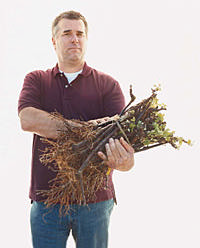 Mark Aubert has a distinguished winemaking career including ten years at Peter Michael. He grew up in the Napa Valley where he was more likely to drink wine and Champagne than beer. His father was a pharmacist who made Petite Syrah and Cabernet on the side. Mark graduated from Fresno State with a degree in enology and minors in chemistry and viticulture. He began his life as a winemaker at Monticello where he made their first leesstirred Chardonnay. He struck up a friendship with Helen Turley who was consulting for Peter Michael. When the assistant winemaker at Peter Michael departed, Helen hired Mark. In 2000, Mark left Peter Michael to become the winemaker for Colgin, again replacing Helen Turley. At the same time, he started his own label, Aubert Wines. He bought a 7-acre Chardonnay vineyard in the Vine Hill area near Forestville (renamed Lauren Vineyard) and near by planted another vineyard with 6 acres of Chardonnay and 1.5 acres of Pinot Noir (Reuling Vineyard). The budwood for the Reuling Vineyard is from a famous source in Vosne-Romanee. He currently has four vineyard-designated Chardonnays (Ritchie Vineyard, Quarry Vineyard, Reuling Vineyard, Lauren Vineyard) and two Pinot Noirs (Reuling Vineyard, UV Vineyard), all in the Sonoma Coast appellation. Mark is a true garariste and his tasting room is an unpretentious metal shed. 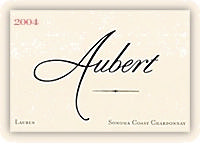 Mark has a love for Burgundy and is a fan of Dujac, Jayer, Leroy and Meo-Camuzet (who isn’t?). His initial Pinot Noir releases were the 2004 Reuling Vineyard Sonoma Coast Pinot Noir (100 cases - 4 barrels) and the 2004 UV Vineyard Sonoma Coast Pinot Noir (also made in very small quantities). These wines are sold by invitation through a mailing list (www.aubertwines.com, 707-942-5611). Mark’s wife, Teresa handles the business side of the label.
2004 Aubert Reuling Vineyard Sonoma Coast Pinot Noir 15.6% alc.. Mark’s notes on the vintage: “The old world Pinot Noir selections survived the September heat nicely. The grapes were vatted for nearly 30 days and then aged in new French oak for 14 months. This cuvee has a real intensity of power in and across the palate.” Parker has called his wines “packed and stacked,” and he’s got that right. · This is an excellent example of the California fruit-forward style. The fruit here, however, is ripe, not over-ripe, in other words, it is concentrated Pinot extract rather than super-ripe juice. One taster likened this wine to a “purple velvet pillow.” A very plush and profound wine that is fat in the mouth. Noticeable oak but in a good way. The alcohol peaks out slightly. Great with the duck.
2004 Aubert UV Vineyard Sonoma Coast Pinot Noir 15.8% alc.. The UV Vineyard is a 30-acre Sonoma Coast vineyard leased by Mark Aubert and vineyard manager Ulises Valdez, planted to Chardonnay and Pinot Noir. The Pinot Noir clone is Calera selection, reputed to be, but never proven, cuttings from La Tache in Vosne-Romanee. Mark’s notes on the vintage: “This vineyard is juxtaposed to our other Aubert vineyard sites (Lauren and Reuling). The blocks were planted on a rare soil type called “Sebastopol Clays,” and grafted to low vigor rootings. Very intense soil driven aromas of wet clay-earthen notes.” · This Pinot has more subdued aromatics than the Reuling, but there were definite wet leaf, earthy notes combined with mushroom and tea aromas. The flavors exhibited strong loamy characters along with interesting anise, tea leaves, and spice highlights. The consensus was that this wine was more “Burgundian” than the Reuling, whatever that means. It was a teeth-staining, masculine Pinot Noir, rich, long and pure on the palate. The wine was blessed with lively underlying acidity and a finish that left a lasting impression. It was almost criminal that we opened a magnum of this wine in addition to some 750s, as this will prove to be a marvelous wine down the road.
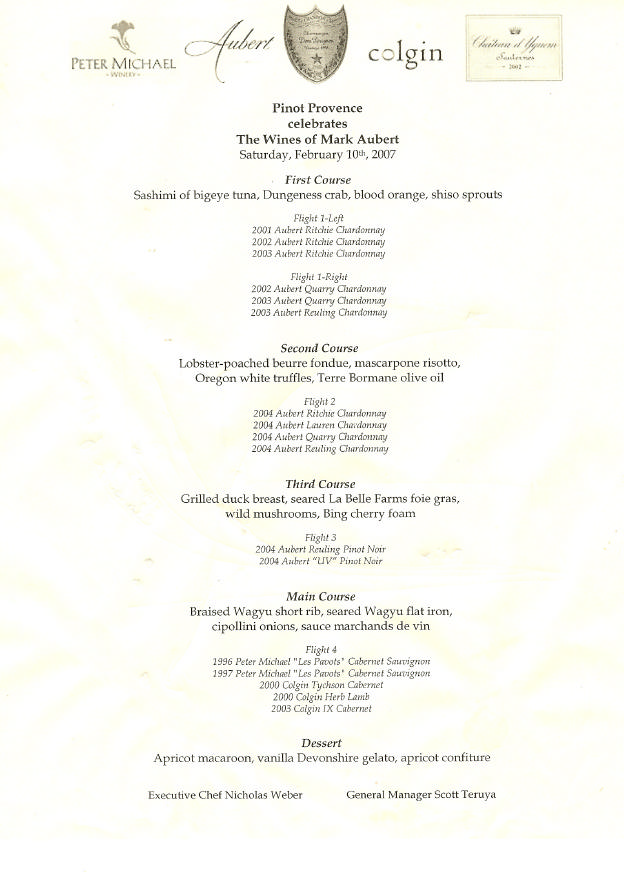
2007 Hospices of SonomaThe 2007 Hospices of Sonoma will be held Saturday, April 21, at the Warren G. Dutton, Jr. Agricultural Pavilion at Shone Farm in Forestville. This is the nation’s largest Pinot Noir barrel auction. The beneficiaries include the Children’s Village of Sonoma County (provides nurturing stable family homes in a multi-generational, enriched environment for children and their siblings in foster care), the Okizu Foundation (based in Novato, this organization provides services and support to families with children battling cancer), the WCC Charitable Foundation (provides direct grants to children at risk in Sonoma County), and Barry Zito’s “Strikeouts for Troops” (a charity founded by baseball pitcher Barry Zito, to support injured military service members and their families). The Hospices of Sonoma weekend begins with limited-seating dinners at selected wineries on Friday evening, April 20 ($125 pp). The Saturday event begins with a pre-auction barrel tasting at 3:30 PM, followed by a dinner, the auction, and a performance by singer Eddie Money and his band ($325 pp). A weekend combination package for both Friday and Saturday is available for $400. The event features donations of half barrels of one-of-a-kind Pinot Noirs crafted specifically for the auction by 35 to 40 of top Pinot Noir producers in the Sonoma Coast, Russian River Valley, Green Valley and Carneros (Sonoma) appellations. A half barrel is auctioned off in two lots, each consisting of five cases of wine. The wines are bottled with a distinctive Hospices of Sonoma wine label and a personalized cuvee name designated by the buyer. Last year the event raised $350,000. The single largest bid was $10,000 for five cases of goldridgepinot. Other high bids included Kosta Browne ($7,200), Radio- Coteau ($6,800), Lynmar ($6,500), Scherrer ($6,000), and Patz & Hall ($6,000). Participating producers this year include: Chasseur, Davis Family Vineyards, De Loach Vineyards, The Donum Estate, DuNah Vineyard & Winery, Dutton Estate Winery, Dutton-Goldfield, Failla Wines, Flowers Vineyard & Winery, Foppiano Vineyards, Freeman Vineyards & Winery, Gary Farrell Vineyards & Winery, Gloria Ferrer, goldridgepinot, Halleck Vineyard, Hartford Family Winery, Inman Family Wines, Iron Horse Vineyards, J Vineyards & Winery, Kosta Browne Winery, Landmark Vineyards, Lynmar Winery, MacMurray Ranch, MacPhail, Marimar Estate, Martinelli, Olivet lane Vineyard, Patz & Hall Wine Co, Paul Hobbs Wines, Radio- Coteau, Russian Hill Estate Winery, Schug Carneros Estate, Siduri Winery, Tandem Winery, TR Elliott, and Wild Hog Vineyard. I will be attending the event and hope to meet up with some of the Crew to taste some one-of-a-kind Pinot Noirs for a very special cause. Tickets are now available: 707-823-9463, www.hospicesofsonoma.org.
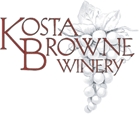
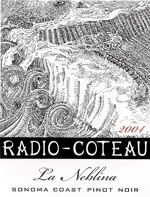
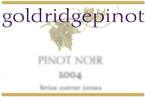
Pinot ParadiseThey call the Santa Cruz Mountains a “paradise for Pinot Noir,” and this annual event celebrates the bounty from the many small wineries scattered throughout the appellation. The region has been receiving considerable recognition recently for its distinctive Pinot Noirs. (see PinotFile, Volume 5, Issue 30). 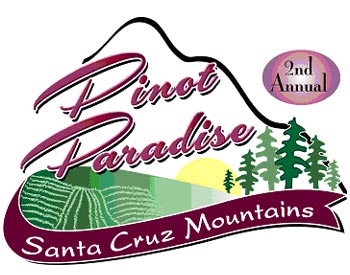 On Saturday, March 17, 2007, from 11:00 AM to 5:00 PM wineries will be open for tours and tasting. Called the Pathway to Pinot Paradise, this event is only $25 per person. Many of these wineries are small, family-owned affairs that are not usually open to the public. It is a great opportunity to poke around the mountain landscape and discover hidden tiny wineries that specialize in Pinot Noir. Participating wineries include Bargetto Winery, Beauregard Vineyards, Burrell School Vineyards, Domenico Winery, Generosa Winery, Hallcrest Vineyards, Martin Alfaro Family Vineyards, Nicholson Vineyards, Pleasant Valley Vineyards, Roudon-Smith Winery, Silver Mountain Vineyards, Sonnet Wines, Thomas Fogerty Vineyards & Winery, Vine Hill Winery, Windy Oaks Estate Vineyards & Winery. On Sunday morning, March 18, 2007 there are Technical Sessions at Villa Ragusa in Campbell ($65 per person including lunch). Featured speakers are John Haeger, author of North American Pinot Noir, Prudy Foxx, vineyard consultant in the Santa Cruz Mountains, Jim Schultze, proprietor of Windy Oaks Estate Vineyards & Winery, Jerome Aubin, representing Tonnellerie Rousseau in Burgundy, France, and Jeff Bareilles, Sommelier at Manresa Restaurant who will lead the group through a comparative tasting of Pinot Noirs from Santa Barbara, Santa Lucia Highlands, Santa Cruz Mountains, Russian River Valley, and the Willamette Valley. Lunch will be next door at the Sonoma Chicken Coop. On Sunday, March 18, from 2:00 PM to 5:00 PM the Grand Cruz Tasting ($65 per person) will be held at Villa Ragusa with over 26 producers (many listed above) pouring their Pinot Noirs. For reservations and tickers call the Santa Cruz Mountains Winegrowers’ Association at 831-685-8463 or visit the website, www.scmwa.com. A Paradise Pass for both Saturday and Sunday events is $125 per person. Useful lodging and restaurant information is also available on the SCMWA website.
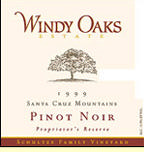  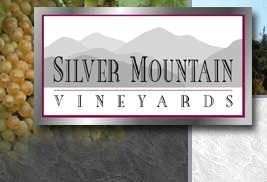 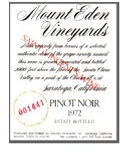
A Case of Bien NacidoBien Nacido Vineyards in the Santa Maria Valley has released its inaugural Bien Nacido Collectors Case. This is a singular offering of Bien Nacido Pinot Noirs, Chardonnays, Syrahs, and Pinot Blancs. The goal is to exhibit the typicity of the Bien Nacido Vineyard while saluting the stylistic choices of some of California’s most talented winemakers. The selections will change with subsequent vintages. The Pinot Noir producers included in the first Collectors Case are Nicolaysen, Lane Tanner, and Stephen Ross. Other producers offering other varietals are Jaffurs, Ojai Vineyard, Qupe, Summerland, Tantara, Au Bon Climat, Makor, Trou de Blonde, and J. Wilkes. One bottle from 12 different producers. The price is $395 a case. For further information and ordering go to www.biennacidovineyards.com. 
2005 Burgundy - First Reports are GlowingAlan Meadows, aka the Burghound (www.burghound.com) has been studying and drinking Burgundy for over 30 years. His opinions on Burgundy are unmatched in the wine world. So when his latest review of the 2005 and 2004 vintages of the Cote de Nuits starts with the declaration, “2005: Arguably the Best Vintage in a Generation,” you have to take notice. 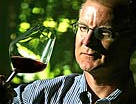 Meadows has heard a lot of vintage hype for years, but 2005 appears to be the real deal. He says “2005 is quite simply the best top to bottom vintage that I have ever seen, period, full stop. 2005 is so good that it blows the next closest recent contender, 1999, right out of the water. In short, mortgage your house, sell your dog, hock your spouse (but don’t forget where, you’ll eventually need someone to enjoy these wines with!) or do whatever you have to do but don’t miss the best wines of the vintage or you will I believe live to regret it. Finally, just to be sure that I have your attention, the 2005s are the best wines since the magnificent 1978s.” There is always some bad news to go with the good news and in this case (sic), the 2005 Burgundies will cost you some serious money. According to Meadows, “The first tranche pricing that I have seen is up 10 to 20% over 2004, which given the superior quality is reasonable. Second and later tranche pricing though is likely to get ugly.” One important thing to remember is the quality is great from top to bottom, meaning Bourgogne and Village level wines from top producers will be ones to search for with selective purchasing of 1er Crus. The Grand Crus will be beyond most drinker’s reach and easily rival their 2003 Bordeaux first growth counterparts in price. The old saying, “Burgundy is great if you can get someone else to buy it for you,” definitely applies here. For a full report on the 2005 Burgundies including extensive tasting notes, subscribe to the burghound reports issued quarterly. The cost is $125 per year ($225 for 2 years) for the electronic version. The subscription also includes access to the largest database of drinking notes on Burgundies going back to many distinguished older vintages of the last century. Called the “ultimate Burgundy reference”, this is no overstatement. |
